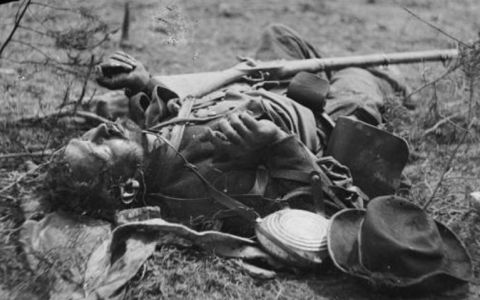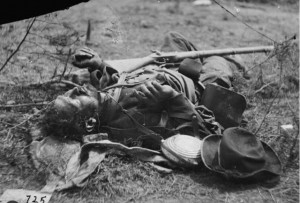Americans have a perhaps understandable tendency to romanticize the Civil War, a four-year “Iliad” that remade the nation at the cost of at least 750,000 lives. Its effects still echo through our present-day controversies over the legacy of slavery, the display of Confederate symbols and even our remembrance of the war itself. For some Americans, the Civil War remains a tragic epic of “brother against brother,” for others a triumphal crusade against slavery, for others an epic of Southerners defending their rights against a soulless Yankee war machine, and for still others simply an inspiring saga of heroic warriors slugging it out on battlefields whose names—Bull Run, Shiloh, Gettysburg—still glow with a near-sacred aura. The armies of re-enactors who bloodlessly refight battles over the war’s once blood-soaked fields testify to the degree to which the Civil War retains its grip on our imaginations.
Declaring that “too much romanticism about the Civil War pervades the present-day view of the conflict,” the authors of this illuminating, ambitious and unsentimental history— Williamson Murray, an emeritus professor of history at Ohio State, and Wayne Wei-siang Hsieh, a history professor at the U.S. Naval Academy—aim to strip the war down to its cold essentials. This is not a grunt’s eye view, it should be said: “A Savage War” evokes little sense of battle as it was experienced by the ordinary soldier, and its descriptions of combat are serviceable rather than stirring. But it is an exceptionally lucid account of the war as it was fought by the generals, a few brilliant but most mediocre, who struggled with primitive logistical support, unreliable communications, exhausted soldiers and the “fog of war” on battlefields that were literally befogged with gun smoke.
The authors’ treatment of the war’s major campaigns is trim and informative, and their analysis of leadership, strategy and the starkly different cultures of the major armies incisive. They also bring to bear a wide-ranging knowledge of military thinkers from Thucydides to Churchill, as well as of wars both ancient and modern. Describing the untrained armies of both North and South at the start of the Civil War, for instance, the authors write: “While the ragtag armies of ill-trained volunteers the opposing sides put in the field in 1861 resembled the enthusiastic but green armies of Revolutionary France in 1792, the hard survivors who fought the battles of 1864 and 1865 foreshadowed the Western Front of 1914 and 1915.”
Readers seeking a more vivid, less command-centered narrative account of the war in a single volume might consider, as a companion volume, either James McPherson’s sweeping “Battle Cry of Freedom” or Bruce Catton’s dated but still superb “The Civil War,” while Allen Guelzo’s “Fateful Lightning: A New History of the Civil War and Reconstruction” fluently presents the political and social context of the war, which the authors of “A Savage War” must sometimes skimp.
Although, like most historians, Messrs. Murray and Hsieh regard Robert E. Lee as the most talented commander produced by the war, they consider Ulysses S. Grant his near equal and in some ways his superior. They persuasively judge Grant’s 1863 capture of Vicksburg, Miss.—after fighting and winning half a dozen battles, outmaneuvering two Confederate armies and bagging one of them to the last man—to be “the most impressive campaign of the Civil War.” (The disputatious might nominate Stonewall Jackson’s 1862 Shenandoah Campaign or Lee’s Seven Days Battles the same year.) Although Grant was outnumbered by the enemy in the Vicksburg campaign, his movements “were so quick and unexpected that the Confederates never grasped his intentions.” Grant’s decision to abandon his supply lines and live off the land also provided the crucial template for Sherman’s devastating march through Georgia and the Carolinas later in the war.
Some of the authors’ most intriguing insights concern campaigns that never happened. After Vicksburg, Grant planned a campaign to capture Mobile, Ala., that would choke off one of the Confederacy’s few remaining ports and establish a federal base of operations for the invasion of the Confederacy’s agricultural heartland. Grant further proposed a joint land-and-sea assault from the Union-held coast of Virginia and North Carolina that would strike inland to capture Raleigh and interdict the railroads that supplied the Confederate capital of Richmond, thereby forcing the Southerners to evacuate most of Virginia and indirectly eastern Tennessee. Had Grant been allowed to carry out his plans, the war might have come to an end much sooner, but they were scotched by his notoriously unimaginative superior, Henry Halleck, the Washington-based general in chief of the Army, misnamed “Old Brains.” Halleck’s strategic conservatism not only thwarted Grant but also hobbled, when it did not cripple, the Union’s best-equipped and, until 1864, worst-led force, the Army of the Potomac.
The Army of the Potomac, the authors write, was one of the Civil War’s two “most peculiar” armies. The other was the Confederacy’s Army of Tennessee, which fought in the trans-Appalachian West. Both “managed through four years of fighting to accumulate the most appalling record of lost battles,” despite the fact that the armies’ “human material” was much the same as that of more successful armies. “How the armies developed their individual cultures suggests much about leadership and the creation of an effective military culture as well as the difficulties involved in altering a dysfunctional command climate,” the authors write.
They attribute the Army of the Potomac’s limitations to the lingering influence of George B. McClellan, who imposed a rigidly hierarchical command structure when he led the army in 1861 and 1862. The Army of Tennessee’s lackluster record they blame squarely on its longtime commander Gen. Braxton Bragg, a cruel and intolerant man who fostered a “backbiting” headquarters atmosphere that undermined his army’s morale. In the East, the superbly equipped but haplessly sluggish Yankees were out-generaled by Lee, who encouraged enterprise in his subordinates and repeatedly defeated the Army of the Potomac until Grant took overall command in 1864.
By that year, the war had grown more savage. In April, Confederates under the prewar slave trader Nathan Bedford Forrest wantonly slaughtered some 300 black federal troops who had surrendered at Fort Pillow, in Tennessee. Union soldiers retaliated. A few weeks after Fort Pillow, a Wisconsin infantryman wrote to his family: “Twenty-three of the rebs surrendered but our boys asked if they remembered Fort Pillow and killed all of them. Where there is no officer with us, we take no prisoners.” Such “paybacks,” the authors say, may have been more common than the heroizing narrative that came to dominate the postwar writing of popular Civil War history suggested.
For the first three years of the war, the leading generals of both the Union and the Confederacy struggled to achieve “a Napoleonic ‘decisive’ victory,” an ever-elusive knockout blow that would end the war. But Union generals in particular failed to realize that the Confederacy relied not just on its armies but, assert the authors, “in moral and psychological forces rooted in a potent sense of national identity.”
The mass mobilization of the Confederacy’s people and resources for the war effort rendered the hope of a quick, decisive victory moot. “As has been the case of most major wars since 1807, the Civil War turned into a war of attrition, one in which victory rested on which side could take the most punishment and remain standing at the end,” the authors write. “The destruction of the white South represented a deliberate and successful strategy to break the will of an intransigent, deeply committed enemy.” That would only be accomplished by the “hard war” strategy embraced by Grant and by his trusted lieutenants, Gens. William T. Sherman on his march to the sea and Philip Sheridan in the Shenandoah Valley. Both campaigns devastated the Confederacy economically and psychologically.
Could the South have prevailed, despite the North’s superior numbers and industrial base? The Confederacy possessed certain advantages: a territory almost the size of Western Europe, a white population committed to independence, almost four million slaves whose forced labor freed white males for military service, and the economic value of its cotton. In addition, a large segment of the Northern population vociferously opposed the war. Had George McClellan, the candidate of the Democratic Party running on a peace platform, gone on to victory in the 1864 presidential election—as Lincoln feared he would as late as the summer of that year—he would likely have canceled the Emancipation Proclamation and left slavery intact as the price for reunion: The 13th, 14th and 15th Amendments would never have come to pass.
The authors do not often indulge in such counterfactual speculation. But they rightly point out that “contingency and chance are the great determinants of history” and note that “the Civil War’s many profound effects on American society all flowed from a torrent of individual acts and events diverging in multiple directions.” Put simply, the Union’s ultimate victory was no sure thing.
—Mr. Bordewich’s most recent book is “The First Congress: How James Madison, George Washington and A Group of Extraordinary Men Invented the Government.”




